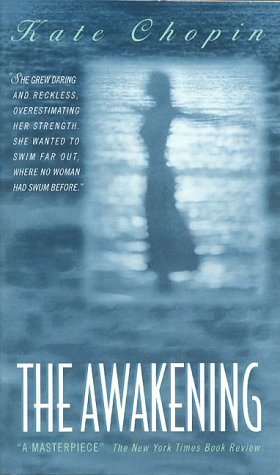What a surprise to learn that "The Awakening," controversial for its time, was published in 1899. Contemporary authors of Kate Chopin were Henry James, Joseph Conrad and Theodore Dreiser. A female principal character was quite unusual. Featuring one who is not satisfied with being a wife, mother and keeper of a home with servants created criticism for author Chopin.
Edna Pointellier, the main character, seems to have it all — a successful and devoted (if often remote) husband, adorable young children and a moneyed lifestyle that has her summering on Grand Isle, a resort island off of New Orleans, with servants both there and at home. Currents of mild dissatisfaction arise, as in Edna’s response to Robert, a handsome young man from a prominent family who pays lavish attention to her. He is not her only young male admirer and Edna does not discourage their attentions.
Yet it is from her female acquaintances on the isle that Edna first envisions a pathway to self‐discovery that she seems to need. Her feeling toward her husband and children is one of indifference, except for occasional bursts of affection. Adele Ratignolle, one of the looked‐up-to wives and mothers, encourages Edna’s beginning interest in art. A bond between the two develops, leading to touches and caresses. But it is a conventional relationship which does not go farther.
That comes closer with Edna’s next woman friend, the unconventional and outspoken Mademoiselle Reisz. An older woman pianist who encourages Edna’s interest in painting, she openly admires Edna’s beauty almost like a lovesick suitor, although, again, it does not go farther physically. Edna reacts emotionally to the woman’s playing, especially of Chopin, but her dreams center around Robert who has continued to pay a great deal of attention to her. Edna dreams of them going away together, but she is still receptive to the attentions of her other suitor, Alcee Arobin, especially when Robert departs for a lengthy trip.
As a developing artist, Edna moves toward a bit of self-identity when a dealer purchases some of her sketches. But soon she departs from her husband’s house to rent a cozy four‐room cottage nearby, telling Mademoiselle Reisz that she is tired of dealing with the servants needed to run a large home. Her husband writes her an immediate letter of disapproval, but Edna’s mind is on different things, and for some time she has not taken her marriage seriously. She reacts by giving an elaborate dinner party for a group of friends, sending the bill to her husband. The return of Robert brings that relationship to a decisive point.
This is an intriguing and well‐written novel, which, despite its turn of the 20th century publication, has relevance for today, even with the multitudes of opportunities open to women. Author Chopin wrote several previous novels and a number of short stories which were well received. But this one, with its controversial ending, had a devastating impact on public opinion of her and pretty much finished her literary career.









